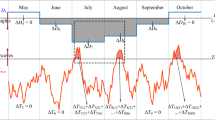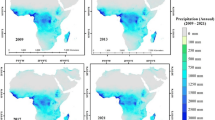Abstract
Dengue is one of the most serious vector-borne infectious diseases in India, particularly in Kolkata and its neighbouring districts. Dengue viruses have infected several citizens of Kolkata since 2012 and it is amplifying every year. It has been derived from earlier studies that certain meteorological variables and climate change play a significant role in the spread and amplification of dengue infections in different parts of the globe. In this study, our primary objective is to identify the relative contribution of the putative drivers responsible for dengue occurrences in Kolkata and project dengue incidences with respect to the future climate change. The regression model was developed using maximum temperature, minimum temperature, relative humidity and rainfall as key meteorological factors on the basis of statistically significant cross-correlation coefficient values to predict dengue cases. Finally, climate variables from the Coordinated Regional Climate Downscaling Experiment (CORDEX) for South Asia region were input into the statistical model to project the occurrences of dengue infections under different climate scenarios such as Representative Concentration Pathways (RCP4.5 and RCP8.5). It has been estimated that from 2020 to 2100, dengue cases will be higher from September to November with more cases in RCP8.5 (872 cases per year) than RCP4.5 (531 cases per year). The present research further concludes that from December to February, RCP8.5 leads to suitable warmer weather conditions essential for the survival and multiplication of dengue pathogens resulting more than two times dengue cases in RCP8.5 than in RCP4.5. Furthermore, the results obtained will be useful in developing early warning systems and provide important evidence for dengue control policy-making and public health intervention.





Similar content being viewed by others
References
Arunachalam N et al (2004) Studies on dengue in rural areas of Kurnool District, Andhra Pradesh, India. J Am Mosq Control Assoc 20:87–90
Azil AH, Long SA, Ritchie SA, Williams CR (2010) The development of predictive tools for pre-emptive dengue vector control: a study of Aedes aegypti abundance and meteorological variables in North Queensland, Australia. Tropical Med Int Health 15:1190–1197
Bandyopadhyay B et al (2013) A comprehensive study on the 2012 dengue fever outbreak in Kolkata, India. ISRN Virol 2013:207580
Banerjee S, Aditya G, GKJ S (2015) Household wastes as larval habitats of dengue vectors: comparison between urban and rural areas of Kolkata, India. PLoS One 10:e0138082
Barnes WJ, Rosen LJT (1974) Fatal hemorrhagic disease and shock associated with primary dengue infection on a Pacific island. Am J Trop Med Hyg 23:495–506
Biswas DK, Bhunia R, Basu MJ (2014) Dengue fever in a rural area of West Bengal, India, 2012: an outbreak investigation. WHO South East Asia J Public Health 3:46
Böhning D (1994) A note on a test for Poisson overdispersion. Biometrika 81:418–419
Breslow NE (1984) Extra-Poisson variation in log-linear models. 33:38–44
Cameron AC, Trivedi PK (2013) Regression analysis of count data vol 53. Cambridge university press
Census (2011) Census of India government of India, New Delhi
Chatterjee S, Chakraborty A, Sinha SK (2015) Spatial distribution & physicochemical characterization of the breeding habitats of Aedes aegypti in & around Kolkata, West Bengal, India. Indian J Med Res 142:S79
Chaturvedi U, Nagar R (2008) Dengue and dengue haemorrhagic fever: Indian perspective. J Biosci 33:429–441
Colón-González FJ, Fezzi C, Lake IR, Hunter PR (2013) The effects of weather and climate change on dengue. 7:e2503
Dawn A (2014) A spatio-temporal analysis of dengue fever in West Bengal with special reference to Kolkata municipal corporation area. IOSR J 19:46–55
Debnath F, Ponnaiah M, Acharya P (2017) Dengue fever in a municipality of West Bengal, India, 2015: An outbreak investigation. Indian J Public Health 61:239
Dutta SE et al. (2017) Dengue: an exaggeration or a nemesis? An hospital based study in the northern part of west Bengal, India
Fairos WW, Azaki WW, Alias LM, Wah YBJIJM (2010) Modelling dengue fever (DF) ande dengue haemorrhagic fever (DHF) outbreak using Poisson and negative binomial model. Comput, Phys Electr Comput Eng 4:46–51
Fernandes MV, Schmidt AM, Migon HS (2009) Modelling zero-inflated spatio-temporal processes. Stat Model 9:3–25
Gubler DJ (1998) Dengue and dengue hemorrhagic fever. Clin Microbiol Rev 11:480–496
Gubler DJ (2002) The global emergence/resurgence of arboviral diseases as public health problems. Arch Med Res 33:330–342
Hati AJJVBD (2009) Dengue serosurveillance in Kolkata, facing an epidemic in West Bengal, India. J Vector Borne Dis 46:197–204
Hati AK, Bhattacharjee I, Mukherjee H, Bandyopadhayay B, Bandyopadhyay D, De R, Chandra G (2012) Concurrent dengue and malaria in an area in Kolkata. Asian Pac J Trop Med 5:315–317
Hindu (2017) https://www.thehindu.com/news/national/tamil-nadu/dengue-vaccine-to-be-ready-by-2020/article21968574.ece
IMD (2014) IMD (Kolkata) https://wwwimdkolkatagovin/tourist/kolkata_tourism_weather_info_1.pdf
Jeelani S, Sabesan SJIJCMAS (2013) Aedes vector population dynamics and occurrence of dengue fever in relation to climate variables in Puducherry, South India Int J Curr Microbiol App Sci 2(12):313–322. http://www.ijcmas.com
Koopman JS, Prevots DR, Mann MAV, Dantes HG, Aquino MLZ, Longini Jr IM, Amor JSJAjoe (1991) Determinants and predictors of dengue infection in Mexico 133:1168–1178
Lambert D (1992) Zero-inflated Poisson regression, with an application to defects in manufacturing. Technometrics 34:1–14
Li C, Wang X, Wu X, Liu J, Ji D, Du J (2017) Modeling and projection of dengue fever cases in Guangzhou based on variation of weather factors. Sci Total Environ 605:867–873
Meinshausen M et al (2011) The RCP greenhouse gas concentrations and their extensions from 1765 to 2300. Clim Chang 109:213
Mutheneni SR, Morse AP, Caminade C, Upadhyayula SM (2017) Dengue burden in India: recent trends and importance of climatic parameters. Emerg Microbes Infect 6:e70
Nagao Y, Svasti P, Tawatsin A, Thavara U (2008) Geographical structure of dengue transmission and its determinants in Thailand. Epidemiol Infect 136:843–851
Pandey N, Nagar R, Gupta S (2012) Trend of dengue virus infection at Lucknow, north India (2008–2010): a hospital based study. Indian J Med Res 136:862
Poddar S, Sengupta P, Chandra G, Hati AK (2016) Effects of the weather on dengue infections in Kolkata, India 6
Ridout M, Hinde J, Demétrio CG (2001) A score test for testing a zero-inflated Poisson regression model against zero-inflated negative binomial alternatives. Biometrics 57:219–223
Rigau-Pérez JG, Clark GG, Gubler DJ, Reiter P, Sanders EJ, Vorndam AV (1998) Dengue and dengue haemorrhagic fever. Lancet 352:971–977
Sanjay J, Ramarao M, Mujumdar M, Krishnan R (2017) Regional Climate Change Scenarios. In: Observed Climate Variability and Change over the Indian Region. Springer, pp 285–304
Sarkar J, Chakravarty S, Sarkar RK (1972) Sporadic cases of haemorrhage and/or shock during dengue epidemics. Trans R Soc Troc Med Hyg 66:875–877
Struchiner CJ, Rocklöv J, Wilder-Smith A, Massad E (2015) Increasing dengue incidence in Singapore over the past 40 years: population growth, climate and mobility. PLoS One 10:e0136286
Taylor KE, Stouffer RJ, Meehl GA (2012) An overview of CMIP5 and the experiment design. Bull Am Meteorol Soc 93:485–498
Telle O et al (2016) The spread of dengue in an endemic urban milieu–the case of Delhi, India. PLoS One 11:e0146539
Thai KT, Anders KL (2011) The role of climate variability and change in the transmission dynamics and geographic distribution of dengue. Exp Biol Med (Maywood) 236:944–954
Thammapalo S, Chongsuwiwatwong V, McNeil D, Geater A (2005) The climatic factors influencing the occurrence of dengue hemorrhagic fever in Thailand. Southeast Asian J Trop Med Public Health 36:191–196
TOI (2019) https://timesofindia.indiatimes.com/city/kolkata/bengal-wages-biological-war-against-dengue/articleshow/70884248.cms Times of India 29 August
Wang P, Puterman ML, Cockburn I, Le NJB (1996) Mixed Poisson regression models with covariate dependent rates. Biometrics 52:381–400
Wang C, Jiang B, Fan J, Wang F, Liu Q (2014) A study of the dengue epidemic and meteorological factors in Guangzhou, China, by using a zero-inflated Poisson regression model. 26:48–57
Wu P-C, Guo H-R, Lung S-C, Lin C-Y, Su HJ (2007) Weather as an effective predictor for occurrence of dengue fever in Taiwan. Acta Trop 103:50–57
Wu X, Lu Y, Zhou S, Chen L, Xu B (2016) Impact of climate change on human infectious diseases: empirical evidence and human adaptation. Environ Int 86:14–23
Zhang Y et al (2016) Developing a time series predictive model for dengue in Zhongshan, China based on weather and Guangzhou dengue surveillance data. PLoS Negl Trop Dis 10:e0004473
Acknowledgements
We are thankful to the anonymous reviewers and the editor (Scott C. Sheridan) for constructive suggestions that improved the manuscript substantially. Sourabh Bal (SB) was supported by Free University (FU), Berlin, for his 3-month research stay at the Institute for Meteorology, FU as a guest researcher. SB is grateful to Indian Meteorological Department (IMD), Kolkata, for allowing him to use their library facilities for data access.
Author information
Authors and Affiliations
Corresponding author
Additional information
Publisher’s note
Springer Nature remains neutral with regard to jurisdictional claims in published maps and institutional affiliations.
Rights and permissions
About this article
Cite this article
Bal, S., Sodoudi, S. Modeling and prediction of dengue occurrences in Kolkata, India, based on climate factors. Int J Biometeorol 64, 1379–1391 (2020). https://doi.org/10.1007/s00484-020-01918-9
Received:
Revised:
Accepted:
Published:
Issue Date:
DOI: https://doi.org/10.1007/s00484-020-01918-9




